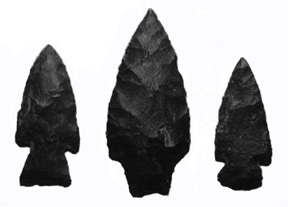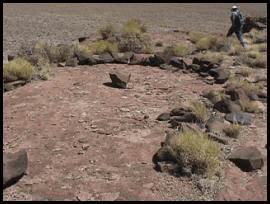How Long Ago?
Dates of occupation are based currently on surface finds of temporally/culturally
diagnostic items, such as projectile points (spear or arrow points) and trade
beads. In short, projectile points can offer a relative date to researchers
based on the fact that certain styles
(link shows an example of projectile point chronology for the Northwest
Plains) for points (e.g., corner-notched, side-notched, basally-notched,
unnotched, etc.) were made at certain times in the past and the broad patterns
of the associated dates have been worked out by archeologists. Our estimated
dates for the sites at Taboose Pass range from at least 1000 BC to 1850 AD.
Additional, more precise dating may come with planned obsidian studies.
 |
| Obsedian projectile points: right and left are Rose Spring corner notch |
Projectile points (arrowheads and spear points) can be roughly dated from their design. Projectile points of the Rose Spring and Cottonwood types mark late prehistoric and historic use of at least four of the recorded sites. Associated dates are 600 AD to approximately 1850 AD. The recovery of two trade beads from site CA-FRE-3105*. further underscores post-1820 historic use, as glass beads can be dated fairly close to the decade of their manufacture. The beads are of a type ("blue hexagonals") traded by the Hudson's Bay Company to Native American groups in California, and elsewhere.
Additional late prehistoric occupation is suggested by the presence of Desert Side-notched projectiles at sites CA-FRE-3094 and West Taboose #9 (a field number).
Earlier (older) occupation of the area's alpine zone is suggested by the recovery of an Elko Corner-notched point fragment at Taboose Pass (dating to perhaps 1000 BC). A single Elko-eared point (broken and reworked in the past) was also recovered from site West Taboose #12. At this point, no material has been recovered that could be dated via the Carbon-14 method, such as charcoal or animal bone. Perhaps this more precise dating technique can be used in the future. It would be an excellent way to get much more precise dates.
 |
|
Native American rock ring site, Great Basin. |
The presence of stone circle features is noted for site CA-FRE-3105. The features are associated with chipped stone (obsidian tools and fragments), ground stone (a mano and metate), and steatite (or soapstone) vessel fragments. The steatite fragments likely represent the remains of some sort of bowl or pot. At site West Taboose #19 a single stone circle feature was recorded; chipped stone and ground stone were also present but steatite was not observed here.
What do these stone circles represent? We infer that the stone circles mark the outlines of shelters and/or hunting blinds. Similar stone circles are well known elsewhere as marking the foundations of skin-covered or brush-covered shelters (e.g., windbreaks or wickiups). They may also mark the outlines of blinds, behind which hunters hid to take game by surprise. Also, domestic and hunting debris is found in and around the stone circles; a pattern that further suggests a shelter or a blind. The stone circle features are also in close proximity to ephemeral water courses, which is another common hunting or camping pattern. However, no identifiable animal remains have yet been encountered that that could help define what animals may have been hunted (mule deer? bighorn sheep? marmots?).
We feel that the use of site CA-FRE-3105, with its stone circle features, was likely cyclical and spanned, minimally, hundreds of years. Similarly, the recovery of datable projectile points at site West Taboose #19 indicate occupation spanning several hundreds of years. It seems likely that families or small groups of hunters returned repeatedly over the centuries to use the temporary shelters inferred from the stone circles.
Perhaps most intriguing is the possibility that the presence of women and children can be argued for given the occurrence of manos and metates, along with a handful of other ground stone items at both site CA-FRE-3105 and West Taboose #19. Such tools are frequently considered "domestic" items, or more often "women's" items. Some sort of plant processing is inferred nonetheless (e.g., pinyon pine nuts, acorns, bilberry, and "taboose" or nut grass). Right now, it's an open question as to whether the sites in the Taboose Pass area reflect the presence of men only, or whether extended families may have been present, at least for some periods in the past. It's an interesting question.
We cannot yet say what groups are responsible for the sites thus far recorded. It seems equally possible that either westside (of the Sierra Crest) or eastside groups account for the sites (perhaps both). We do speculate however that the predominance of Fish Springs obsidian argues somewhat more strongly that Owens Valley groups (e.g., Paiutes) had ready access to the raw material and could more easily make treks to Taboose Pass to trade this stone tool material with westside groups (e.g., Yokuts or Western Mono) who would, most likely, have arrived via the watershed of the Kings River. The historic movement of peoples, goods, and culture across the southern Sierra Nevada certainly extends back in time. How far back and to what degrees remain to be seen.
*NOTE: By convention, archeologists number sites via a "trinomial" system. First comes the state abbreviation, then the county abbreviation, and then a sequential number starting with "1", such that CA-FRE-3105 is the three-thousandth-one-hundred-and-fifth site recorded in Fresno County, California.
Recommended Readings
Grayson, Donald
K.
1992 The Desert's Past: A Natural Prehistory of the Great Basin. Smithsonian
Institution Press. Washington and London.
Heizer, Robert
F. (editor)
1978 Handbook of North American Indians, Vol. 8: California. Smithsonian Institution,
Washington, D.C.
Steward, Julian
H.
1933 Ethnography of the Owens Valley Paiute. University of California Publications
in American Archaeology and Ethnology 33(3):233-350.
Links
National Park Service: Links to the Past
Information on North American archaeology and sites.
Lithics Net
A great resource for projectile data and terminology as well as links to other
archeological sources.
Our Founder Questions? Go to About Our New Site |
Masthead
Photo from: |